14.3: High Intelligence-Nature or Nurture; Learning Disabilities
- Page ID
- 113220
This page is a draft and under active development. Please forward any questions, comments, and/or feedback to the ASCCC OERI (oeri@asccc.org).
Learning Objectives
- Describe how genetics and environment affect intelligence
- Explain the relationship between IQ scores and socioeconomic status
- Describe the difference between a learning disability and a developmental disorder
Overview
A young girl, born of teenage parents, lives with her grandmother in rural Mississippi. They are poor—in serious poverty—but they do their best to get by with what they have. She learns to read when she is just 3 years old. As she grows older, she longs to live with her mother, who now resides in Wisconsin. She moves there at the age of 6 years. At 9 years of age, she is raped. During the next several years, several different male relatives repeatedly molest her. Her life unravels. She turns to drugs and sex to fill the deep, lonely void inside her. Her mother then sends her to Nashville to live with her father, who imposes strict behavioral expectations upon her, and over time, her wild life settles once again. She begins to experience success in school, and at 19 years old, becomes the youngest and first African-American female news anchor (“Dates and Events,” n.d.). The woman—Oprah Winfrey—goes on to become a media giant known for both her intelligence and her empathy.
High Intelligence: Nature or Nurture?
Where does high intelligence come from? Some researchers believe that intelligence is a trait inherited from a person’s parents. Scientists who research this topic typically use twin studies to determine the heritability of intelligence. The Minnesota Study of Twins Reared Apart is one of the most well-known twin studies. In this investigation, researchers found that identical twins (100% of their DNA is identical) raised together and identical twins raised apart exhibit a higher correlation between their IQ scores than siblings (50% of their DNA in common) or fraternal twins (50% of their DNA in common) raised together (Bouchard, Lykken, McGue, Segal, & Tellegen, 1990). The findings from this study reveal a genetic component to intelligence (Figure 10.3.1). At the same time, other psychologists believe that intelligence is shaped by a child’s developmental environment. If parents were to provide their children with intellectual stimuli beginning from before they are born, it is likely that they would absorb the benefits of that stimulation, and it would be reflected in intelligence levels.
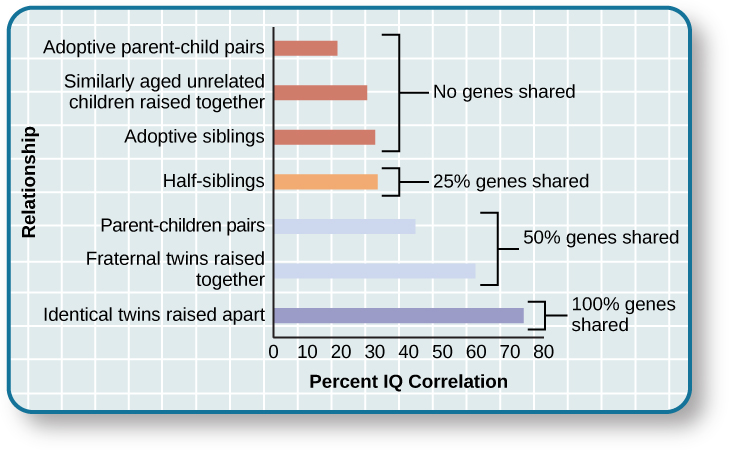
The reality is that aspects of each idea are probably correct. One study suggests that genetics seem to be in control of the level of intelligence, environmental influences are also involved (Bartels, Rietveld, Van Baal, & Boomsma, 2002). Certainly, there are behaviors that support the development of intelligence, but the genetic component of high intelligence can not be ignored. As with all heritable traits, however, it is not always possible to isolate how and when high intelligence is passed on to the next generation.
Range of Reaction is the theory that each person responds to the environment in a unique way based on his or her genetic makeup. According to this idea, your genetic potential is a fixed quantity, but whether you reach your full intellectual potential is dependent upon the environmental stimulation you experience, especially in childhood. Think about this scenario: A couple adopts a child who has average genetic intellectual potential. They raise her in an extremely stimulating environment. What will happen to the couple’s new daughter? It is likely that the stimulating environment will improve her intellectual outcomes over the course of her life. But what happens if this experiment is reversed? If a child with an extremely strong genetic background is placed in an environment that does not stimulate him: What happens? Interestingly, according to a longitudinal study of highly gifted individuals, it was found that “the two extremes of optimal and pathological experience are both represented disproportionately in the backgrounds of creative individuals”; however, those who experienced supportive family environments were more likely to report being happy (Csikszentmihalyi & Csikszentmihalyi, 1993, p. 187).
Another challenge to determining origins of high intelligence is the confounding nature of our human social structures. It is troubling to note that some ethnic groups perform better on IQ tests than others—and it is likely that the results do not have much to do with the quality of each ethnic group’s intellect. The same is true for socioeconomic status. Children who live in poverty experience more pervasive, daily stress than children who do not worry about the basic needs of safety, shelter, and food. These worries can negatively affect how the brain functions and develops, causing a dip in IQ scores. Mark Kishiyama and his colleagues determined that children living in poverty demonstrated reduced prefrontal brain functioning comparable to children with damage to the lateral prefrontal cortex (Kishyama, Boyce, Jimenez, Perry, & Knight, 2009).
The debate around the foundations and influences on intelligence exploded in 1969, when an educational psychologist named Arthur Jensen published the article “How Much Can We Boost I.Q. and Achievement” in the Harvard Educational Review. Jensen had administered IQ tests to diverse groups of students, and his results led him to the conclusion that IQ is determined by genetics. He also posited that intelligence was made up of two types of abilities: Level I and Level II. In his theory, Level I is responsible for rote memorization, whereas Level II is responsible for conceptual and analytical abilities. According to his findings, Level I remained consistent among the human race. Level II, however, exhibited differences among ethnic groups (Modgil & Routledge, 1987). Jensen’s most controversial conclusion was that Level II intelligence is prevalent among Asians, then Caucasians, then African Americans. Robert Williams was among those who called out racial bias in Jensen’s results (Williams, 1970).
Obviously, Jensen’s interpretation of his own data caused an intense response in a nation that continued to grapple with the effects of racism (Fox, 2012). However, Jensen’s ideas were not solitary or unique; rather, they represented one of many examples of psychologists asserting racial differences in IQ and cognitive ability. In fact, Rushton and Jensen (2005) reviewed three decades worth of research on the relationship between race and cognitive ability. Jensen’s belief in the inherited nature of intelligence and the validity of the IQ test to be the truest measure of intelligence are at the core of his conclusions. If, however, you believe that intelligence is more than Levels I and II, or that IQ tests do not control for socioeconomic and cultural differences among people, then perhaps you can dismiss Jensen’s conclusions as a single window that looks out on the complicated and varied landscape of human intelligence.
Learning Disabilities
Learning disabilities are cognitive disorders that affect different areas of cognition, particularly language or reading. It should be pointed out that learning disabilities are not the same thing as intellectual disabilities. Learning disabilities are considered specific neurological impairments rather than global intellectual or developmental disabilities. A person with a language disability has difficulty understanding or using spoken language, whereas someone with a reading disability, such as dyslexia, has difficulty processing what he or she is reading.
Often, learning disabilities are not recognized until a child reaches school age. One confounding aspect of learning disabilities is that they often affect children with average to above-average intelligence. At the same time, learning disabilities tend to exhibit comorbidity with other disorders, like attention-deficit hyperactivity disorder (ADHD). Anywhere between 30–70% of individuals with diagnosed cases of ADHD also have some sort of learning disability (Riccio, Gonzales, & Hynd, 1994). Let’s take a look at two examples of common learning disabilities: dysgraphia and dyslexia.
Dysgraphia
Children with dysgraphia have a learning disability that results in a struggle to write legibly. The physical task of writing with a pen and paper is extremely challenging for the person. These children often have extreme difficulty putting their thoughts down on paper (Smits-Engelsman & Van Galen, 1997). This difficulty is inconsistent with a person’s IQ. That is, based on the child’s IQ and/or abilities in other areas, a child with dysgraphia should be able to write, but can’t. Children with dysgraphia may also have problems with spatial abilities.
Dyslexia
Dyslexia is the most common learning disability in children that causes difficulties in learning to read. An individual with dyslexia exhibits an inability to correctly process letters. The neurological mechanism for sound processing does not work properly in someone with dyslexia. As a result, dyslexic children may not understand sound-letter correspondence. A child with dyslexia may mix up letters within words and sentences—letter reversals, such as those shown in Figure 10.3.2, are a hallmark of this learning disability—or skip whole words while reading. A dyslexic child may have difficulty spelling words correctly while writing. Because of the disordered way that the brain processes letters and sound, learning to read is a frustrating experience. Some dyslexic individuals cope by memorizing the shapes of most words, but they never actually learn to read (Berninger, 2008).
The Brain, Dyslexia, and Dysgraphia
Developmental dyslexia is a heritable neurodevelopmental disorder that impairs reading in individuals with normal intelligence and educational opportunities. Reading requires the coordination of many brain systems. This "reading circuit" includes language mechanisms in Broca's and Wernicke's areas in the frontal and temporal lobes, respectively, as well as systems involved in vision, working memory, attention, movement and cognition. Processing of printed words takes place within "the visual word form area" located in the fusiform gyrus (also involved in object and face recognition) of the left hemisphere.
.png?revision=1)
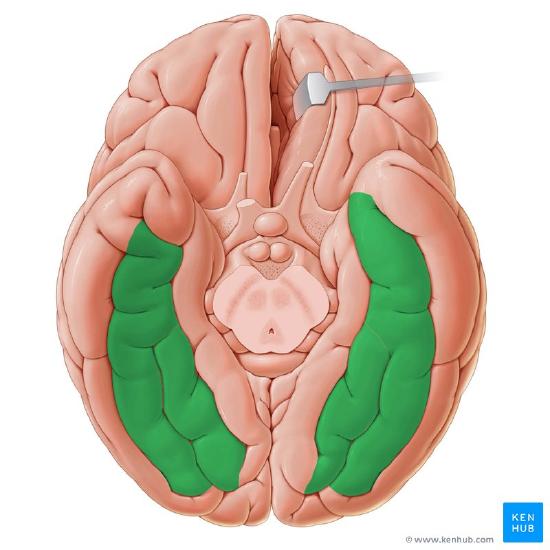
Figure \(\PageIndex{2}\): Fusiform gyrus viewed from bottom of human brain. Note an area for "word form" located in the left fusiform area. (Images from Wikimedia Commons, Fusiform gyrus, retrieved 10/19/21).
Next, a large circuit in the left hemisphere is activated. This circuit includes the supramarginal gyrus (mapping of spelling and other writing conventions to language sounds), the superior temporal gyrus (phonological sound processing), the inferior parietal lobule and the angular gyrus (word-meaning processing) and the inferior frontal gyrus (phonological sound and semantic meaning processing, working memory). In addition, subcortical regions implicated in long-term and working memory, procedural learning and rapid sequential auditory processing (thalamus, basal ganglia and hippocampus) also appear to be involved in reading.
In addition, there is strong evidence for a role of the visual magnocellular (M) system in reading and research suggests a significant role of deficits in the visual magnocellular (M) system in developmental dyslexia (DD). The M and parvocellular (P) pathways are major parallel visual system streams feeding to lateral geniculate nucleus (visual area) of the thalamus, then onto primary visual (striate) cortex, and then to the extrastriate regions of the occipital lobe (i.e., the ‘dorsal’ and the ‘ventral’ visual streams). The ventral stream (the "what" pathway) which involves the inferior temporal cortex is associated with color, form perception, and the discrimination and recognition of objects). The visual magnocellular or dorsal system (the "where" pathway; depth and motion perception) contributes to rapid recognition and sequencing of letters by quickly focusing the ventral attention network (VAN) on the letter to be identified. Finally, left and right fronto-parietal (attentional) networks critically modulate visual and auditory word pathways by selective attention in both temporal and spatial dimensions. The visual magnocellular system (the "where" pathway) is related to the fronto-parietal attentional network. Previous neuroimaging studies have revealed reduced or absent activation within the visual M pathway in DD. Considering the complexity of the circuitry involved in reading, it is likely that a wide range of patterns of neurological deficit in the above mentioned brain areas may contribute to reading difficulties in different individuals (Mascheretti, et al., 2021).
Dysgraphia appears to involve disorder in some brain areas which are not involved in dyslexia. Richards, et al. (2015) used fMRI to study structural white matter integrity and functional connectivity in children with dysgraphia and dyslexia and found significant differences between control group and both the dysgraphic and dyslexic groups in functional connectivity. Left occipital temporal gyrus, supramarginal gyrus, precuneus, and inferior frontal gyrus were used in these analyses because these brain areas were shown in an analysis of prior research to be related to written word production. Dysgraphia and dyslexia differ in white matter integrity, fMRI functional connectivity, and white matter–gray matter correlations.
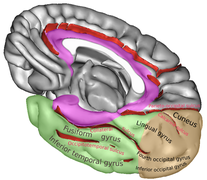
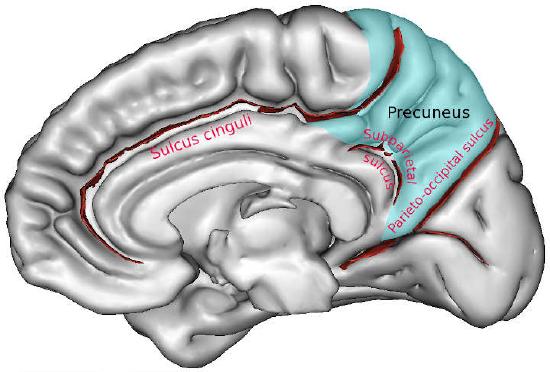
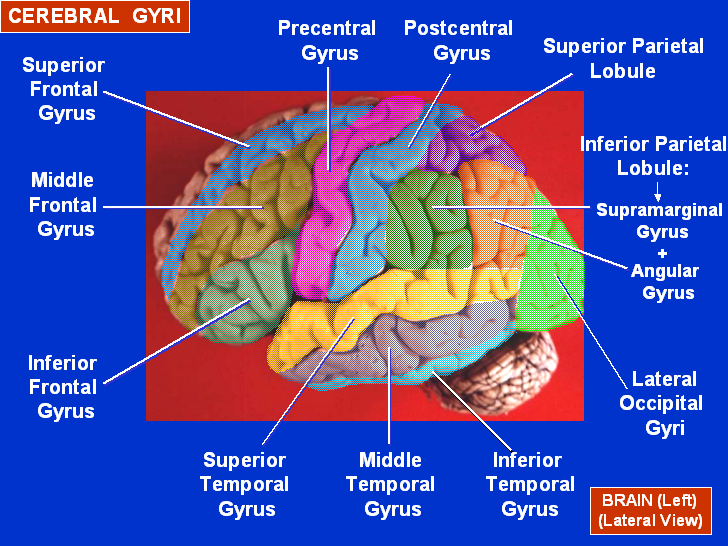
Figure \(\PageIndex{3}\): (top left) Fusiform gyrus (also known as the lateral occipitotemporal gyrus) viewed from bottom of human brain. (top right) Midline view featuring the Precuneus (multiple functions including memory, sensory/perceptual integration, mental imagery strategies) and several other midline sulci. (bottom) Left hemisphere of human brain showing Inferior Frontal gyrus in the Frontal lobe and the Supramarginal gyrus in the Parietal lobe. Decreased white matter integrity and impaired functional connectivity among these structures is associated with dysgraphia. (Images from Wikipedia Commons, Fusiform gyrus, Precuneus, Inferior Frontal gyrus; retrieved 10/19/21. Caption by Kenneth A. Koenigshofer, PhD, including reference to Science Direct, Precuneus; Richards, et al., 2015).
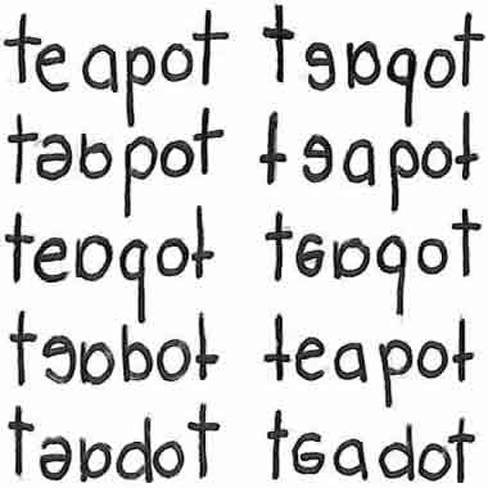
Summary
Genetics and environment affect intelligence and the challenges of certain learning disabilities. The intelligence levels of all individuals seem to benefit from rich stimulation in their early environments. Highly intelligent individuals, however, may have a built-in resiliency that allows them to overcome difficult obstacles in their upbringing. Learning disabilities can cause major challenges for children who are learning to read and write. Unlike developmental disabilities, learning disabilities are strictly neurological in nature and are not related to intelligence levels. Students with dyslexia, for example, may have extreme difficulty learning to read, but their intelligence levels are typically average or above average.
Review Questions
- Where does high intelligence come from?
- genetics
- environment
- both A and B
- neither A nor B
- Arthur Jensen believed that ________.
- genetics was solely responsible for intelligence
- environment was solely responsible for intelligence
- intelligence level was determined by race
- IQ tests do not take socioeconomic status into account
- What is a learning disability?
- a developmental disorder
- a neurological disorder
- an emotional disorder
- an intellectual disorder
- Which of the following statements is true?
- Poverty always affects whether individuals are able to reach their full intellectual potential.
- An individual’s intelligence is determined solely by the intelligence levels of his siblings.
- The environment in which an individual is raised is the strongest predictor of her future intelligence
- There are many factors working together to influence an individual’s intelligence level.
Critical Thinking Questions
What evidence exists for a genetic component to an individual’s IQ?
Describe the relationship between learning disabilities and intellectual disabilities to intelligence.
Personal Application Question
Do you believe your level of intelligence was improved because of the stimuli in your childhood environment? Why or why not?
References
Bartels, M., Rietveld, M., Van Baal, G., & Boomsma, D. I. (2002). Genetic and environmental influences on the development of intelligence. Behavior Genetics, 32 (4), 237–238.
Berninger, V. W. (2008). Defining and differentiating dysgraphia, dyslexia, and language learning disability within a working memory model. In M. Mody & E. R. Silliman (Eds.), Brain, behavior, and learning in language and reading disorders (pp. 103–134). New York: The Guilford Press.
Bouchard, T. J., Lykken, D. T., McGue, M., Segal, N. L., & Tellegen, A. (1990). Sources of human psychological differences: The Minnesota Study of Twins Reared Apart. Science, 250, 223–228.
Csikszentmihalyi, M., & Csikszentmihalyi, I. (1993). Family influences on the development of giftedness. Ciba Foundation Symposium, 178, 187–206.
Fox, M. (2012, November 1). Arthur R. Jensen dies at 89; Set off debate about I.Q. New York Times, p. B15.
Jensen, A. R. (1967). How much can we boost IQ and scholastic achievement?. Harvard Educational Review.
Kishyama, M. M., Boyce, W. T., Jimenez, A. M., Perry, L. M., & Knight, R. T. (2009). Socioeconomic disparities affect prefrontal function in children. Journal of Cognitive Neuroscience, 21(6), 1106–1115.
Mascheretti, S., Peruzzo, D., Andreola, C., Villa, M., Ciceri, T., Trezzi, V., ... & Arrigoni, F. (2021). Selecting the Most Relevant Brain Regions to Classify Children with Developmental Dyslexia and Typical Readers by Using Complex Magnocellular Stimuli and Multiple Kernel Learning. Brain Sciences, 11(6), 722.
Modgil, S., & Routledge, C. M. (Eds.). (1987). Arthur Jensen: Consensus and controversy. New York: Falmer Press.
Riccio, C. A., Gonzales, J. J., & Hynd, G. W. (1994). Attention-deficit Hyperactivity Disorder (ADHD) and learning disabilities. Learning Disability Quarterly, 17, 311–322.
Richards, T. L., Grabowski, T. J., Boord, P., Yagle, K., Askren, M., Mestre, Z., ... & Berninger, V. (2015). Contrasting brain patterns of writing-related DTI parameters, fMRI connectivity, and DTI–fMRI connectivity correlations in children with and without dysgraphia or dyslexia. NeuroImage: Clinical, 8, 408-421.
Rushton, J. P., & Jensen, A. R. (2005). Thirty years of research on race differences in cognitive ability. Psychology, public policy, and law, 11 (2), 235–294.
Smits-Engelsman, B. C. M., & Van Galen, G. P. (1997). Dysgraphia in children: Lasting psychomotor deficiency or transient developmental delay? Journal of Experimental Child Psychology, 67, 164–184.
Williams, R. L., (1970). Danger: Testing and dehumanizing black children. Clinical Child Psychology Newsletter, 9 (1), 5–6.
Attributions
Adapted by Kenneth A. Koenigshofer, PhD., from The Source of Intelligence by Rice University, Licensed CC BY-NC 4.0 via OER Commons


